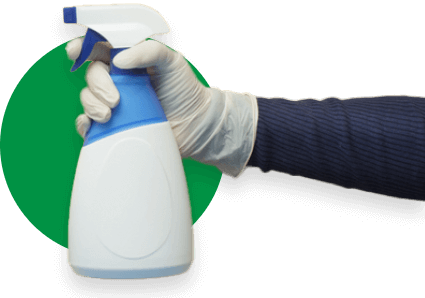Slip-and-fall accidents are among the most common workplace injuries. While these incidents usually end up injuring victims, they can also harm your company’s bottom line.
From insurance claims and lost productivity to legal liability, one slick floor can trigger costly consequences. Whether you manage an office, retail space, warehouse, or healthcare facility, keeping floors safe is one of the most practical ways to protect everyone who walks through your doors.
Here are five expert tips to reduce accidents, comply with safety standards, and embed slip prevention into your company culture.
Why Businesses Need Slip and Fall Prevention
Did you know that around one million emergency room visits are the result of slip and fall accidents? For businesses, these incidents represent a significant financial and legal liability. The consequences extend far beyond the immediate injury, creating a cascade of potential problems:
- Financial Costs: The average workers’ compensation claim for a slip-and-fall can cost thousands, not including potential lawsuits, increased insurance premiums, and fines.
- Legal Liability: Under the OSHA General Duty Clause (Section 5(a)(1)), employers must provide a workplace “free from recognized hazards.” This clause explicitly covers fall risks, including wet floors and uneven walkways. Failure to do so can result in significant OSHA violations and citations, demonstrating a lack of OSHA compliance.
- Productivity Loss: An injured employee means lost workdays, and the incident investigation itself requires time and resources, diverting focus from core business operations.
- Reputational Damage: Compliance is critical, but the need for safer floors goes beyond adherence. Preventing slips and falls preserves trust. When clients, employees, or customers see a spotless, dry surface, it signals professionalism and care. One accident can undo that perception in an instant, damaging your brand’s reputation.
Ultimately, investing in robust slip-and-fall prevention is a core component of a healthy workplace safety culture and sound financial management.
Tip 1: Maintain Clean, Dry Floors to Prevent Slip and Fall Accidents
Water, grease, or even cleaning residue can turn a stable surface into a hazard. That’s why the first line of defense is consistent floor maintenance.
- Clean and dry regularly: Create cleaning schedules based on foot traffic and risk. High-use areas such as lobbies, kitchens, break rooms, and restrooms should be cleaned and inspected multiple times a day. A “clean as you go” policy is essential for spills.
- Use floor mats and runners: Install absorbent mats at entrances and exits to capture moisture from shoes. Replace them as soon as they become saturated.
- Adjust by season: During rainy or winter months, increase cleaning frequency and add extra entryway mats.
- Partner with professionals: Find a qualified janitorial provider that utilizes commercial-grade equipment, traction-safe products, and quick-drying techniques that minimize downtime and reduce risk. Professionals understand the difference between cleaning for appearance and cleaning for safety, ensuring no slick residues are left behind.
Clean floors aren’t just appealing; they’re your first and most important layer of fall prevention.
Tip 2: Use Proper Signage and Barriers in Your Business
- Post “Wet Floor” signs immediately. Then, take it a step further by posting signs that are both bright and visible, especially during cleaning and after spills.
- Mark maintenance areas! Place barriers around leaks, repair zones, or equipment cleaning sites.
- Stay OSHA-compliant. Signs must be legible, color-coded, and clearly visible to people before they enter a hazard zone.
- Remove signage promptly. After our team has cleaned up your floor, take the signs away! Leaving caution signs out too long causes “sign fatigue,” reducing effectiveness.
Tip 3: Improve Lighting and Visibility in the Workplace
Poor lighting hides danger. Dim hallways, flickering bulbs, and uneven light distribution can make puddles or cords almost invisible.
- Take regular inventory of your lighting. Check for shadows in stairways, corridors, and entry points.
- If you realize you need better lighting, upgrade to LED. Energy-efficient LED fixtures provide brighter, more uniform light and last longer than fluorescent options.
- Finally, install motion-sensor lighting throughout your office. Smart lighting ensures key areas stay illuminated only when in use, improving safety and efficiency.
Tip 4: Schedule Routine Floor Inspections and Maintenance
No matter the material of your floor, it’s a fact that your flooring will wear down over time.
Sealants fade, grout loosens, and tiles lift; all of which increase the risk.
- On a weekly basis, assign team members to inspect the floors for slick spots or lifted tiles.
- Commercial flooring, especially vinyl and tile, should be refinished every 6–12 months to maintain traction.
- OSHA compliance often relies on documentation. Keep written records of all inspections, maintenance requests, and repairs. This log demonstrates due diligence in the event of an incident or audit.
- A certified cleaning team can detect early signs of wear and safely handle refinishing, ensuring compliance without downtime. Our cleaners don’t just clean, they document and help you meet all of your compliance goals.
Tip 5: Educate Employees and Cleaning Staff on Slip and Fall Prevention
People are your strongest defense, especially if they’re trained.
- Make floor safety part of onboarding and recurring training. Take the time to ensure every employee has been trained in floor safety.
- Teach staff to immediately report leaks, spills, or worn mats.
- Equip janitorial staff with floor cleaning safety training, emphasizing the proper use of chemicals and the importance of signage.
- Post reminders in breakrooms and cleaning closets to keep safety top of mind.
Simple awareness turns every worker into a safety advocate.
Common Causes of Slip and Fall Accidents in Commercial Settings
Most falls are preventable, but hazards often go unnoticed. Identifying these common culprits is the first step toward mitigating them.
- Wet floors: the most common cause. Hazards include spills, freshly mopped areas, tracked-in rain or snow, and leaks from pipes or equipment.
- Poor floor maintenance: Worn flooring with faded finishes, loose tiles, cracked concrete, or bunched carpeting can create uneven, high-risk surfaces.
- Inadequate lighting: Poor lighting hides danger. Dim hallways, flickering bulbs, and uneven light distribution can make wet floor hazards or small objects nearly invisible.
- Debris or clutter: Boxes, cords, tools, and other items left in high-traffic zones create obvious tripping hazards.
- Seasonal challenges: Entryways are a major battleground. Rain, mud, or tracked-in snow can turn a lobby into a danger zone within minutes.
Each environment presents unique challenges. For example, slip prevention in stores requires constant attention to spills and entryway moisture, while industrial slip prevention focuses on heavy-duty flooring and managing material or oil spills.
At Dallas Janitorial Services, we understand how to approach these unique challenges and are prepared to map out a cleaning schedule that keeps your floors safer!
Tools and Products That Enhance Workplace Safety
Modern tools like those we use at Dallas Janitorial Services make a significant difference:
- Non-slip coatings: Boost traction on tile, concrete, or vinyl flooring.
- Anti-fatigue mats: Improve comfort while reducing moisture buildup.
- Moisture sensors: Detect spills or leaks in real time.
- Industry-safe cleaners: Use pH-neutral solutions to prevent residue that can increase slickness.
For high-traffic environments like warehouses or events, consult Dallas Janitorial about event floor safety and material-specific coatings. We’ve seen it all and can help!
Creating a Slip and Fall Prevention Plan for Your Business
Building a formal prevention plan is easier than it sounds and is the best way to ensure consistency. Start with this checklist:
- Assign Accountability: Designate a specific safety coordinator or team to oversee the plan.
- Inspect Floors: Perform daily walk-throughs of high-traffic areas, noting spills, wear, and clutter.
- Clean Proactively: Schedule professional cleaning services during off-hours to minimize disruption and ensure thorough drying.
- Use Signage: Enforce a zero-tolerance policy for leaving wet zones unmarked.
- Track Incidents: Keep a detailed log of any slips or near-misses. Use this data to spot recurring problem areas or times of day.
Integrating these steps into your facility workflow keeps you prepared for audits and significantly reduces long-term liability.
How Professional Cleaning Services Reduce Slip and Fall Risks
Professional cleaning teams like Dallas Janitorial Services combine experience, safety training, and advanced equipment to keep your facility compliant and accident-free.
- OSHA-Aligned Techniques: We follow all regulatory guidelines for wet-floor management, ensure correct floor-cleaning safety protocols, and adhere to appropriate drying times.
- Traction-Safe Products: Our solutions are chosen for their ability to clean effectively without leaving a harmful or slick residue.
- Industry-Specific Care: Our services adapt to each environment’s unique risks. For example, clinic walkway safety requires antimicrobial cleaning and dry finishes, while industrial spaces need non-slip coatings that resist oil and debris.
Don’t wait for an accident to happen; keep your business protected. Contact Dallas Janitorial today for professional cleaning and floor care that helps prevent slips and falls.
Slip and Fall Safety FAQs
What causes most slip and fall accidents?
Wet floors, poor maintenance, cluttered pathways, and inadequate lighting are the leading causes of accidents. Spills, tracked-in rainwater, and worn finishes increase risk.
What is the OSHA standard for slip and fall?
OSHA’s walking-working surfaces rule (29 CFR 1910 Subpart D) outlines employer duties to keep floors clean, dry, and hazard-free. The General Duty Clause also applies.
How can businesses prevent slip and fall injuries?
Maintain dry floors, use caution signage, improve lighting, conduct regular inspections, and train staff to identify and report hazards.
How often should business floors be inspected for safety?
At a minimum, inspect high-traffic areas daily. Schedule comprehensive maintenance reviews monthly or seasonally, based on your facility, type, and foot traffic.







